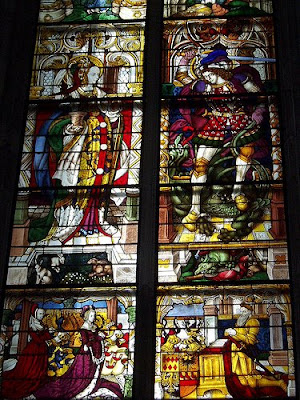
Medieval stained glass window from Ely Cathedral. This window appears to depict scenes from ordinary medieval life.
Below is a partial caption from the photographer:
"The story of Ely Cathedral begins in Saxon Times with the life of its founder,St. Etheldreda.St. EtheldredaEtheldreda (Æthelthryth, Ediltrudis, Audrey) (d.679), queen, foundress and abbess of Ely. She was the daughter of Anna, king of East Anglia, and was born, probably, at Exning, near Newmarket in Suffolk. At an early age she was married (c.652) to Tondberht, ealdorman of the South Gyrwas, but she remained a virgin. On his death, c.655, she retired to the Isle of Ely, her dowry. In 660, for political reasons, she was married to Egfrith, the young king of Northumbria who was then only 15 years old, and several years younger than her. He agreed that she should remain a virgin, as in her previous marriage, but 12 years later he wished their marital relationship to be normal. Etheldreda, advised and aided by Wilfred, bishop of Northumbria, refused. Egfrith offered bribes in vain. Etheldreda left him and became a nun at Coldingham under her aunt Ebbe (672) and founded a double monastery at Ely in 673. (from FARMER, David: The Oxford Dictionary of Saints, 3rd ed. OUP, 1992.)Etheldreda restored an old church at Ely, reputedly destroyed by Penda, pagan king of the Mercians, and built her monastery on the site of what is now Ely Cathedral. After its restoration in 970 by Ethelwold it became the richest abbey in England except for Glastonbury.Etheldreda's monastery flourished for 200 years until it was destroyed by the Danes. It was refounded as a Benedictine community in 970. Etheldreda died c.680 from a tumour on the neck, reputedly as a divine punishment for her vanity in wearing necklaces in her younger days; in reality it was the result of the plague which also killed several of her nuns, many of whom were her sisters or nieces. At St Audrey's Fair necklaces of silk and lace were sold, often of very inferior quality, hence the derivation of the word tawdry from St Audrey.17 years after her death her body was found to be incorrupt: Wilfred and her physician Cynefrid were among the witnesses. The tumour on her neck, cut by her doctor, was found to be healed. The linen cloths in which her body was wrapped were as fresh as the day she had been buried. Her body was placed in a stone sarcophagus of Roman origin, found at Grantchester and reburied.For centuries, Etheldreda's shrine was the focus for vast numbers of medieval pilgrims. It was destroyed in 1541, but a slate in the Cathedral marks the spot where it stood, and the 23 June and 17 October are still kept as major festivals in the Cathedral. Some relics are alleged to be in St Etheldreda's Church, Ely Place, London (where the bishops of Ely formerly had their London residence). Her hand, which was discovered in a recusant hiding place near Arundel in 1811, is claimed by St Etheldreda's Roman Catholic church at Ely"
























